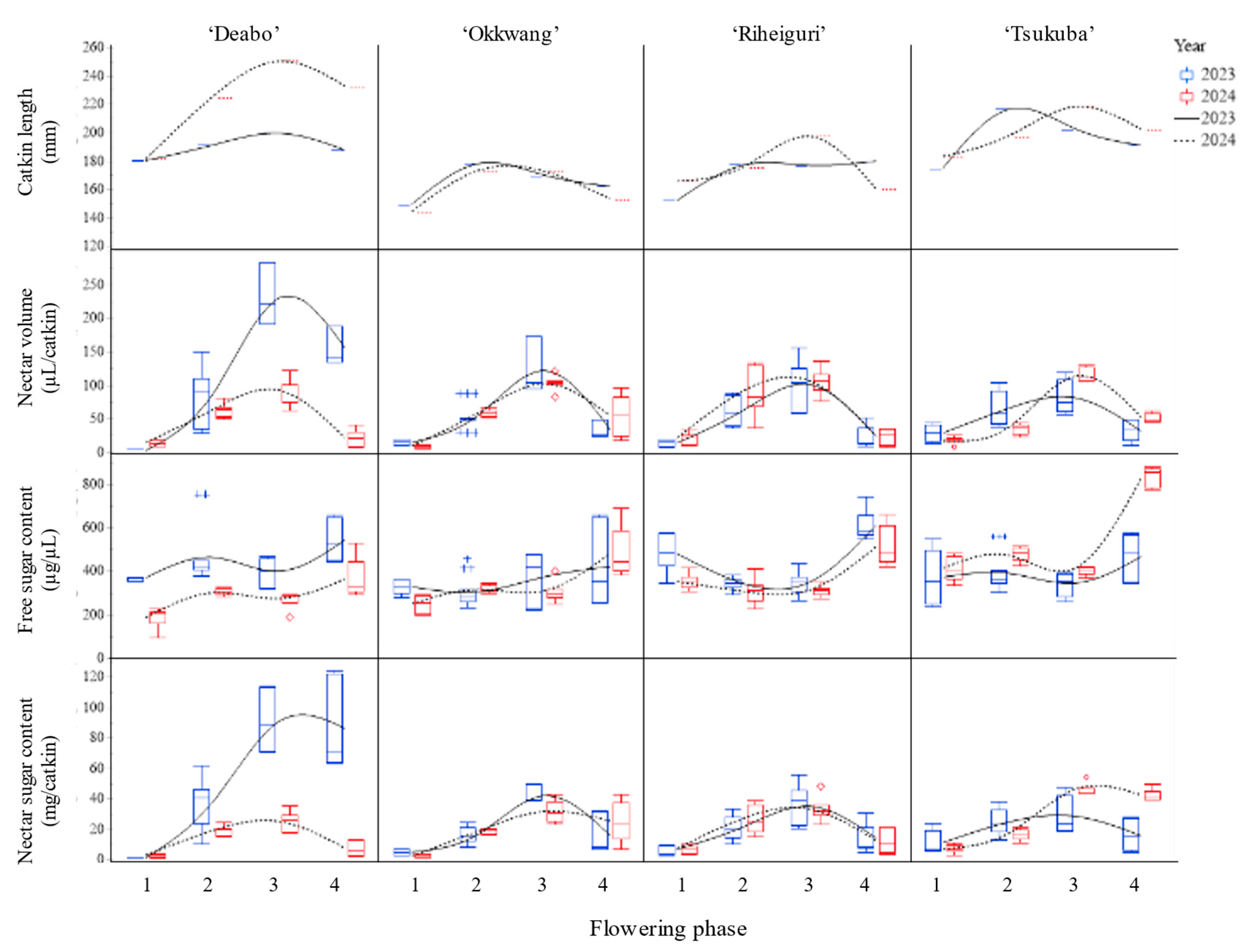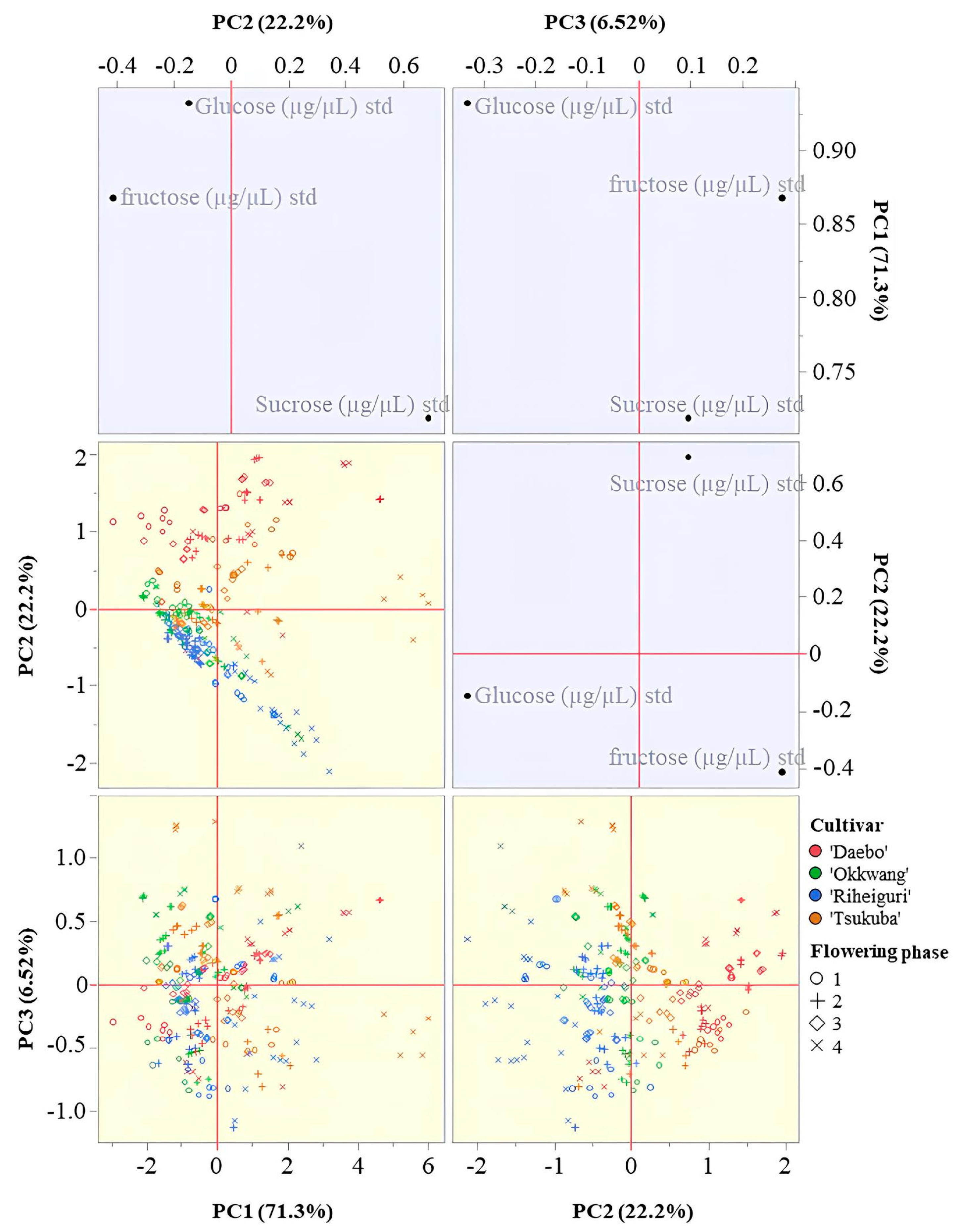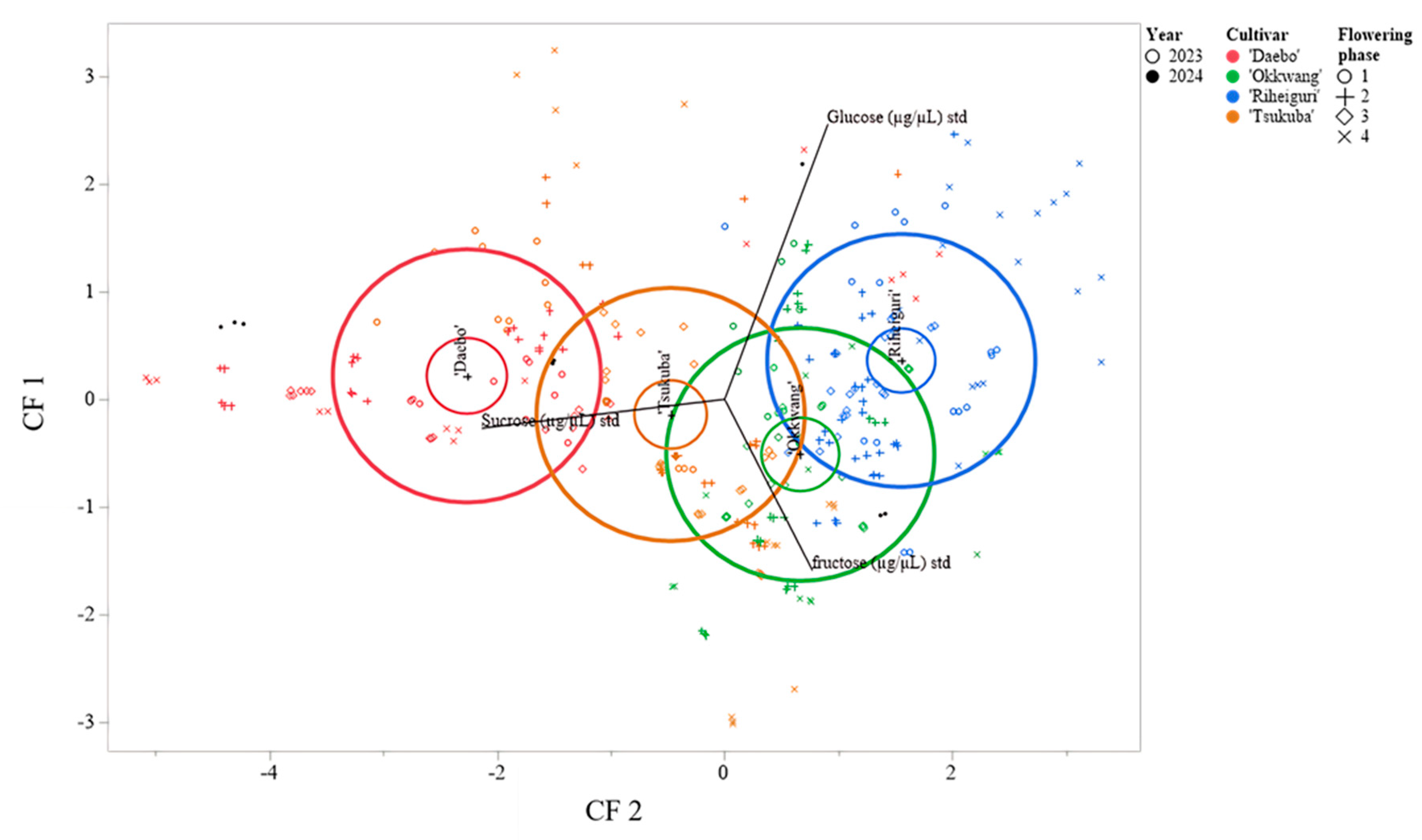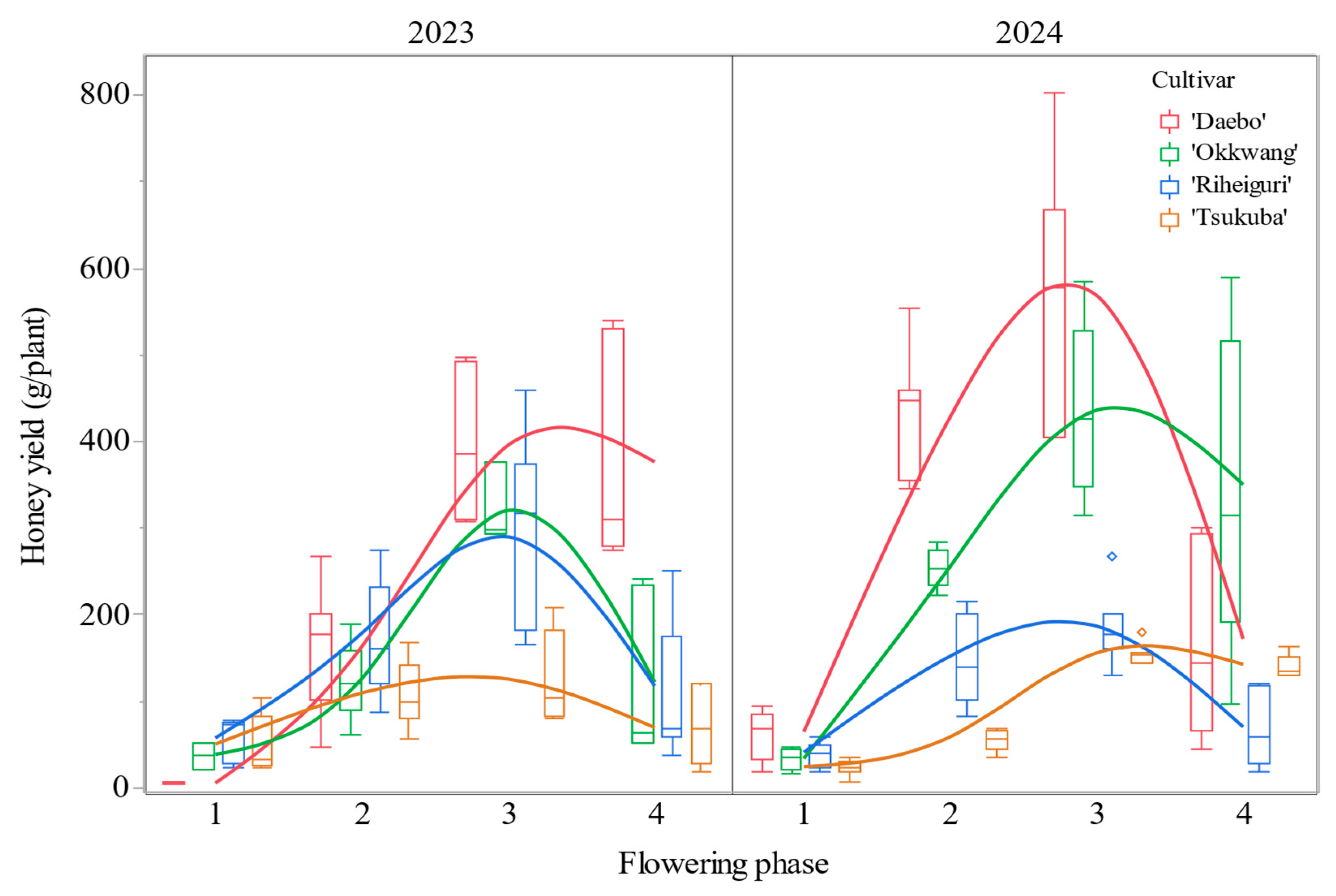1. Introduction
Pollinators, especially
Apis spp., are critically important to both global food security and the maintenance of biodiversity [
1,
2]. However, multiple anthropogenic and environmental stressors, including habitat loss, climate change, pesticide exposure, and poor floral nutrition, are driving widespread pollinator decline [
3,
4,
5]. Among these, the quantity and quality of floral nectar have emerged as central factors influencing bee health, colony resilience, and foraging efficiency [
6,
7]. Nectar serves not only as a primary carbohydrate source but also modulates bee gut microbiota, immune function, and reproductive fitness [
8,
9,
10,
11].
The nutritional value of floral nectar is largely determined by its sugar composition, most notably the concentration and ratio of sucrose, glucose, and fructose [
12]. Nectar rich in monosaccharides is generally favored by bees due to its digestibility [
13,
14,
15]. Moreover, the sugar profile of nectar directly influences the physical and sensory properties of honey, affecting crystallization tendency, flavor, and pharmacological efficacy [
16,
17,
18,
19]. For example, high-glucose honeys crystallize rapidly, while more balanced sugar ratios can enhance both shelf life and taste [
12].
Chestnut trees (
Castanea spp.) are extensively cultivated for nut production throughout the temperate zones of Asia and Europe and are gaining recognition as important melliferous resources. Chestnut honey, especially from
Castanea sativa and
C. crenata, is distinctive for its dark color, high polyphenol content, and bioactive properties, including antioxidant, antibacterial, and anti-inflammatory activities [
20,
21,
22,
23]. Notably, the male flowers of
C. sativa possess high concentrations of kynurenic acid, a neuroprotective metabolite rare among nectar sources [
24]. Korean chestnut honey has demonstrated both antibacterial activity against
Helicobacter pylori and tyrosinase-inhibiting properties with potential cosmetic applications [
21,
25,
26,
27].
Despite its ecological and pharmacological significance, detailed quantitative data on chestnut nectar production remain scarce. Prior studies have primarily focused on morphological and agronomic metrics such as fruit size, harvest date, or leaf phenology rather than nectar characteristics [
28,
29,
30,
31]. Comparative analyses of nectar output across cultivars and flowering stages, especially under standardized, replicated multi-year field conditions, are almost absent. Although some recent studies report differences in nectar volume, sugar profile, and volatile organic compounds among major chestnut cultivars [
28], most prior research lacks systematic, multi-phase comparisons performed with standardized protocols. This gap in the literature limits understanding of how cultivar and flowering phase influence floral nectar traits, which this study aims to address. This research gap is deepened by the unique floral structure of chestnut trees, which produce long, densely flowered male catkins that bloom sequentially and make individual nectar measurements highly challenging. Such complexities result in the need for standardized classification and extraction protocols to allow for meaningful comparison among cultivars.
We selected four widely grown chestnut cultivars in South Korea, ‘Daebo’, ‘Okkwang’, ‘Riheiguri’, and ‘Tsukuba’, because they are commonly used for commercial nut production [
27,
32]. ‘Daebo’ was developed by the National Institute of Forest Science (NIFoS) by crossing the local line ‘Sangmyeon-1’ as the seed parent with ‘Riheiguri’ as the pollen parent in 1976. Selection was finalized in 1998. Trees show strong vigor, long catkins, and abundant flowering. ‘Okkwang’, also bred at NIFoS, originated from selection within a native
Castanea crenata population in Gyeonggi Province, South Korea, and was released in 1965. It shows robust growth with rapid canopy expansion and high fruit set [
32]. ‘Riheiguri’ is a Japanese introduction identified among seedlings from natural hybridization between Japanese and Chinese chestnuts and named in 1950. It combines vigorous growth with cold hardiness and tolerance to pests and diseases [
32]. ‘Tsukuba’, one of Japan’s most widely planted cultivars, was developed at the Japanese Horticultural Research Station from ‘Ganne’ (seed) × ‘Hayadama’ (pollen) and released in 1959. Trees are vigorous with fast canopy development and profuse branching, although they are relatively susceptible to cold and biotic stresses [
32,
33]. These breeding histories provide an informative basis for evaluating genotype effects on floral and nectar attributes.
Through a 2-year replicated field survey (2023–2024), we systematically quantified floral traits, nectar yield, sugar composition, and estimated honey yield across four flowering phases for these cultivars. The objectives of this work were (1) to elucidate cultivar-specific differences in nectar quantity and quality; (2) to identify optimal cultivar–flowering phase combinations for maximizing estimated honey yield and pollinator support; and (3) to generate foundational data to guide Castanea cultivar selection for sustainable agroforestry, pollinator conservation, and apicultural practice. In summary, this study aims to compare nectar traits among four chestnut cultivars and to assess their implications for pollinators and estimated honey yield.
2. Materials and Methods
2.1. Study Site and Plant Materials
This study was conducted in a managed chestnut orchard in Hwaseong, Gyeonggi province, South Korea (37°15′45″ N, 126°55′29″ E). To minimize exogenous variability, no supplemental irrigation or fertilization was applied during the study period; routine pruning and pest management followed local practices. For each cultivar (‘Daebo,’ ‘Okkwang,’ ‘Riheiguri,’ ‘Tsukuba’), three plants of comparable age, vigor, and canopy architecture were randomly selected within the same block (total n = 12 plants). Mean plant height was ~8 m (diameter at breast height ~30 cm). The male flowering period (catkin emergence to senescence) spanned ~20 days each year. For each cultivar and flowering phase, nectar was collected at peak anthesis from 10 catkins per plant in each of three plants (total 30 catkins per phase per cultivar). All collected catkins for each phase and cultivar were pooled to form one composite sample for chemical analysis.
2.2. Catkin Sampling and Nectar Collection
To characterize flowering phenology and quantify nectar secretion in chestnut cultivars, floral observations and catkin sampling were conducted during the early to mid-June flowering season in 2023 and 2024. Flowering phase was determined at the catkin scale based on the proportion of staminate flowers open within a single catkin, rather than on catkin elongation. Four phenological phases were defined at the catkin scale by the proportion of open staminate flowers within a single catkin: phase 1, <25% open; phase 2, 25–50% open; phase 3, >50–100% open; and phase 4, post-anthesis browning/senescence after all staminate flowers had opened (
Figure 1). Phase assignments were made by visual inspection of representative catkins on each plant immediately before nectar sampling, enabling standardized comparisons of floral and nectar traits across cultivars and phases.
For morphological analysis, 30 fully elongated male catkins were randomly collected from four cardinal directions per plant. Catkin length and diameter were measured using a digital caliper (±0.03 mm) (NA500-150S, Bluebird, Zhejiang, China) to assess intra-cultivar variation and provide context for nectar output.
The collection of nectar was conducted at 14:00, under conditions characterized by dry weather and abundant sunlight (no precipitation within the previous 24 h), which is known to coincide with the peak in daily nectar availability. The catkins were covered with pollination bags, a method employed to prevent the loss of nectar due to visits from honeybees and other insect pollinators.
Individual male catkins were centrifuged at 4000 rpm for 4 min at room temperature (RT) using a 50 mL conical tube equipped with a pre-inserted nylon mesh filter in a benchtop centrifuge (ROTOFIX 32 A, Andreas Hettich GmbH & Co. KG, Tuttlingen, Germany). The extracted nectar was immediately quantified using a 100 μL Hamilton micro-syringe (Hamilton Co., Reno, NV, USA). To stabilize and preserve the nectar samples, each was diluted tenfold with an 80% ethanol solution in a sterile 15 mL tube.
After dilution, the nectar solutions were purified by filtration through a centrifugal nylon filter with a 0.45 μm pore size (Millipore Sigma, Billerica, MA, USA) using a 2 mL collection tube. The samples were centrifuged at 4000 rpm for 2 min to remove pollen, debris, and other particulate matter. The purified nectar samples were stored at –20 °C until analysis of sugar concentration and composition.
All procedures followed Na et al. [
34,
35] with minor modifications to accommodate the elongated, sequentially blooming male catkins of
Castanea.
2.3. Analysis of Sugar Contents
Free sugars (sucrose, glucose, fructose) were quantified using HPLC (Dionex Ultimate 3000; Dionex, Sunnyvale, CA, USA) with RI detection (Showa Denko, New York, NY, USA) with an Aminex HPX-87P column (300 × 7.8 mm, Bio-Rad Laboratories, Hercules, CA, USA). Deionized water served as the mobile phase at a flow rate of 0.5 mL/min; oven temperature was set at 80 °C. External calibration used ≥99.5% standards (Sigma Aldrich, St. Louis, MO, USA) over 0.05–2.0 mg mL−1 (R2 ≥ 0.999).
2.4. Estimation of Honey Yield
Potential honey yield per tree was calculated based on nectar sugar content and catkin abundance using the formula:
where 1.15 is the conversion factor representing the sugar-to-honey transformation ratio of 85:100, as applied in previous studies [
36,
37].
2.5. Statistical Analysis
All statistical analyses were performed using JMP Pro 18.1.1 (SAS Institute Inc., Cary, NC, USA), with statistical significance set at p < 0.05. To identify predictors of nectar volume and free sugar content, generalized regression models were fitted with a Gamma distribution and log link using elastic net regularization. Continuous predictor variables were standardized before modeling, and penalty parameters (α, λ) were selected via 5-fold cross-validation following the 1-SE rule. Model performance was summarized using the Akaike Information Criterion (AIC), Bayesian Information Criterion (BIC), and Root Mean Square Error (RMSE).
For analyses of catkin length, nectar volume, free sugar concentration, catkins per tree, and estimated honey yield, generalized linear mixed models (GLMMs; Gamma–log link) were applied. Year and tree (nested within cultivar) were treated as random effects, while cultivar, flowering phase, and their interaction were treated as fixed effects. Post hoc comparisons were conducted with Tukey’s HSD on least-squares means (reported as LSM ± SE).
To assess sugar composition (sucrose, glucose, fructose), multivariate analysis of variance (MANOVA) was performed on standardized data, including fixed effects of cultivar, flowering phase, year, and their two- and three-way interactions. Wilks’ λ and Pillai’s trace were reported for multivariate significance. When significant, univariate ANOVAs with Tukey’s adjustment were subsequently examined. Principal component analysis (PCA) was applied to standardized sugars, retaining principal components based on explained variance (PC1–PC3) and visualized via biplots. Canonical discriminant analysis (CDA) was then used to classify samples by cultivar, with 95% confidence ellipses shown in canonical space, and leave-one-out cross-validation evaluating classification accuracy.
Assumptions of normality, homogeneity of variance, and distributional adequacy were verified prior to all modeling. Shapiro–Wilk tests assessed normality, and Levene’s test assessed homogeneity.
3. Results
3.1. Variation in Floral and Nectar Traits by Cultivar and Flowering Phase
Catkin length and nectar volume were consistently highest at phase 3, with phase-specific peak values observed for each cultivar (
Figure 2). For example, in 2023, ‘Daebo’ exhibited a maximum catkin length of 199.80 ± 20.78 mm at phase 3, while ‘Tsukuba’ reached 216.80 ± 50.47 mm at phase 2, and ‘Riheiguri’ peaked at 180.00 ± 30.62 mm at phase 4. In 2024, maximum catkin lengths were generally observed at phase 3 for ‘Daebo’ (250.67 ± 22.64 mm), ‘Riheiguri’ (198.40 ± 21.27 mm), and ‘Tsukuba’ (218.97 ± 27.69 mm), with ‘Okkwang’ showing similar lengths at phases 2 and 3.
Nectar volume (µL/catkin) peaked at phase 3 in both years (
Figure 2). In 2023, ‘Daebo’ showed the highest nectar volume (232.7 ± 40.63), followed by ‘Okkwang’ (123.7 ± 37.25), ‘Riheiguri’ (101.4 ± 35.42), and ‘Tsukuba’ (81.50 ± 24.60). In 2024, phase 3 maxima shifted, with ‘Tsukuba’ (116.1 ± 9.55), ‘Riheiguri’ (107.3 ± 18.80), ‘Okkwang’ (103.6 ± 11.23), and ‘Daebo’ (94.00 ± 19.89).
Free sugar content (µg/µL) increased from early to late phases, with phase 4 showing the highest values for each cultivar (
Figure 2). In 2023, peak free sugar content at phase 4 was 544.4 ± 89.21 in ‘Daebo’, 610.4 ± 58.85 in ‘Riheiguri’, 468.3 ± 93.09 in ‘Tsukuba’, and 420.7 ± 179 in ‘Okkwang’. In 2024, ‘Tsukuba’ reached the highest phase 4 value (833.2 ± 45.92), with other cultivars ranging from 365.8 to 513.1.
Nectar sugar content (mg/catkin) displayed phase-dependent maxima at phase 3 in both years (
Figure 2). For 2023, ‘Daebo’ reached 91.39 ± 18.45, while ‘Okkwang’, ‘Riheiguri’, and ‘Tsukuba’ showed lower maxima. The 2024 values were highest in ‘Tsukuba’ (46.94 ± 3.53), with remaining cultivars between 25.36 and 33.51.
Significant effects of cultivar, phase, and their interaction for catkin length and free sugar content (
p < 0.001) (
Table 1). For nectar volume and nectar sugar per catkin, cultivar effects were not significant, but the overall phase dependence remained consistent across years.
3.2. Catkin and Nectar Traits: Mixed Model and Regression Analysis
Flowering phase shaped catkin length and nectar characteristics across cultivars and years (
Table A1,
Table 2 and
Table 3). Catkin length was highest in ‘Daebo’ and ‘Tsukuba’ at phase 3. Nectar volume also peaked at phase 3 in all cultivars, while free sugar concentration reached its highest values at phase 4 for ‘Tsukuba’ and ‘Riheiguri’. Nectar sugar content per catkin was greatest at phase 3 in all cultivars, but the ranking among cultivars changed depending on phase and year. Catkin length showed no consistent association with nectar volume or free sugar content across phases. Both nectar volume and free sugar content displayed increased variability at higher mean levels.
Specifically, Catkin length was generally greater in ‘Daebo’ and ‘Tsukuba’, and the maximum in ‘Daebo’ at phase 3 reached 5.40 ± 0.49. Nectar volume was highest at phase 3 for all cultivars, exemplified by ‘Daebo’ at 5.14 ± 0.56, ‘Okkwang’ at 4.74 ± 0.48, and ‘Riheiguri’ at 4.63 ± 0.47. Phase 1 consistently showed the lowest volumes. Free sugar content increased toward late anthesis and was highest at phase 4, exceeding 6.3 in ‘Tsukuba’ and ‘Riheiguri’.
Nectar sugar content per catkin reached a maximum at phase 3 across cultivars, with ‘Daebo’ at 4.09 ± 0.41, ‘Okkwang’ at 3.62 ± 0.39, ‘Tsukuba’ at 3.56 ± 0.36, and ‘Riheiguri’ at 3.52 ± 0.34 (
Table A1). The ordering of cultivars varied by phase and year, and phase-dependent differences in magnitude were observed rather than a fixed hierarchy. Catkin length showed no consistent association with either nectar volume or free sugar content across phases.
Across models, flowering phase was the dominant predictor of nectar traits. Strong effects were recorded for nectar volume (χ
2 = 40.61,
p < 0.0001) and for free sugar concentration (χ
2 = 302.5,
p < 0.0001). A significant cultivar by phase interaction was recorded for nectar volume (χ
2 = 17.63,
p < 0.001), and phase-dependent differences in magnitude among cultivars were observed rather than a uniform ordering across phases (
Table 2). Catkin length did not predict either response (all
p > 0.05).
Dispersion estimates were greater than one for both traits, with nectar volume (φ = 4.308 ± 0.831) and free sugar content (φ = 5.581 ± 1.598) (
Table 3). Both traits showed larger variability at higher mean levels. This pattern reflected biological heterogeneity among catkins and trees across years. After this heterogeneity was modeled in the mixed effects specification, the effect of flowering phase remained significant.
3.3. Sugar Composition in Floral Nectar
Sucrose and glucose in floral nectar generally increased toward phase 4. Fructose showed late-phase increases that were similar or steeper depending on the combination of cultivar and year (
Figure 3). In 2023, ‘Daebo’ showed the highest sucrose in phase 4 (71.27 ± 18.84 µg/µL). In the same year, ‘Riheiguri’ recorded the highest glucose and fructose in phase 4 (136.46 ± 32.78 and 456.97 ± 94.72 µg/µL, respectively). In 2024, ‘Tsukuba’ recorded four maxima across all three sugars (sucrose 77.36 ± 5.98; glucose 206.33 ± 12.10; fructose 549.55 ± 34.16 µg/µL).
The composition of sucrose, glucose, and fructose varied among cultivars and across flowering phases within each year. Each cultivar showed a characteristic progression of sugars through the flowering sequence, and the magnitude and direction of late-phase enrichment differed between years. The combination of cultivar, phase, and year defined discrete nectar sugar profiles that were separable (
Table 4).
Late-phase enrichment of free sugars concentration was observed (
Table 5). In 2023, ‘Daebo’ showed a concurrent rise in all three sugars at phase 4 with sucrose at +2.28, glucose at +0.81, and fructose at +0.87 in standardized units. In 2024, ‘Daebo’ showed a modest elevation in glucose at phase 4 with +0.404, while sucrose was slightly below average with −0.398 and fructose remained below average with −0.362. These patterns show that ‘Daebo’ expressed late-phase enrichment in 2023, while the same phase in 2024 showed a selective increase confined to glucose.
‘Okkwang’ was generally at or below average across many combinations. In 2024, glucose rose above average at phases 1 and 2 with +0.694 and +0.544 and dropped below average at phase 3 with −0.773, then returned to a modestly positive value at phase 4 with +0.296. Fructose in ‘Okkwang’ reached a positive value at phase 4 with +0.938, while sucrose values remained below average across phases in both years. This pattern shows weak late-phase enrichment dominated by glucose in early phases of 2024 and by fructose at phase 4.
‘Riheiguri’ showed higher monosaccharides in specific phases. In 2023, fructose was above average at phases 1 and 2 with +0.870 and +0.920, decreased at phase 3 with −0.934, and returned to a positive value at phase 4 with +0.264. In 2024, ‘Riheiguri’ again showed a late-phase increase in fructose at phase 4 of +1.254 and glucose at phase 4 of +1.022, while sucrose values were below average across phases. These observations show cultivar-specific late-phase accumulation of fructose and glucose in ‘Riheiguri’, with year-dependent magnitude.
‘Tsukuba’ had the strongest late-phase enrichment in 2024. Phase 4 z-scores were +2.572 for sucrose, +3.773 for glucose, and +2.970 for fructose. In 2023, ‘Tsukuba’ showed early phase elevations for glucose and fructose with phase 1 values of approximately +1.002 and +1.054, while later phases were near zero or negative for some sugars. These results show that ‘Tsukuba’ concentrated all sugars strongly at late anthesis in 2024, whereas the 2023 profile was more mixed with early phase elevations.
3.4. Principal Component and Discriminant Analyses of Sugar Composition
PCA of standardized sucrose, glucose, and fructose identified a dominant concentration axis (
Figure 4). PC1 had positive loadings for glucose at 0.932, fructose at 0.868, and sucrose at 0.718 and explained 71.3% of the variance. PC2 explained 22.2% of the variance with a positive loading for sucrose at 0.689 and negative loadings for fructose at −0.412 and glucose at −0.147. PC1 and PC2 together accounted for 93.5% of the total variance. PC3 accounted for 6.5% and showed opposite signs for glucose at −0.331 and fructose at 0.277 with a weak sucrose loading at 0.095.
In the PC1 versus PC2 plane, cultivar positions followed these loading patterns. ‘Tsukuba’ at phase 4 was positioned at high PC1 and negative PC2, which corresponds to nectar with high total sugar and a hexose-rich balance. ‘Daebo’ extended toward high PC1 and positive PC2, which corresponds to high total sugar with a larger sucrose share. ‘Okkwang’ clustered near the origin or slightly negative on both axes, and ‘Riheiguri’ shifted toward negative values on both axes.
CDA based on the same standardized sugars separated cultivar score clouds in the CF1 versus CF2 plot (
Figure 5). The 95% confidence ellipses were distinct for ‘Daebo’, ‘Okkwang’, and ‘Riheiguri’, and a partial overlap was present between ‘Okkwang’ and ‘Tsukuba’. The confusion matrix recorded correct classification rates of 100.0% for ‘Riheiguri’ (27 out of 27), 87.3% for ‘Daebo’ (55 out of 63), 67.2% for ‘Okkwang’ (45 out of 67), and 36.4% for ‘Tsukuba’ (28 out of 44). The misclassification of the subjects was most prevalent in the ‘Tsukuba’ category and was most common in the ‘Okkwang’ category, with 15 out of 44 subjects falling into this category. It was determined that no ‘Riheiguri’ samples were misclassified (
Table 6).
3.5. Estimated Honey Yield
Across all cultivars, yields increased from phase 1 to phase 3 and declined in phase 4. Phase 1 consistently showed the lowest values (
p < 0.001) (
Figure 6).
By cultivar, ‘Daebo’ increased sharply through phases 2–3 to the highest peak among all groups in both years (2023: 397.4 ± 80.21 g/plant; 2024: 572.9 ± 148.8 g/plant), followed by a reduction in phase 4 (2023: 373.6 ± 121.5; 2024: 167.3 ± 106.1 g/plant). ‘Okkwang’ exhibited a monotonic rise to phase 3 (2023: 324.2 ± 40.76; 2024: 437.5 ± 94.14 g/plant) and a subsequent decrease in phase 4 (2023: 118.3 ± 89.95; 2024: 346.1 ± 184.2 g/plant). ‘Riheiguri’ showed intermediate phase 3 maxima (2023: 289.6 ± 109.8; 2024: 186.8 ± 42.47 g/plant) and lower phase 4 values. In contrast, ‘Tsukuba’ yielded the smallest amounts across phases and years, with phase 3 values of 124.8 ± 51.71 (2023) and 155.8 ± 11.73 g/plant (2024). In all cultivars, standard deviations were larger around the phase 3 peak, indicating greater among-tree variability at maximum yield. Furthermore, within phase 3, ‘Daebo’ yielded the most, ‘Okkwang’ and ‘Riheiguri’ were intermediate, and ‘Tsukuba’ remained the lowest (
Figure 6).
The model-based estimates of honey yield per plant demonstrated an increase from phase 1 to phase 3 across all cultivars, followed by a decrease in phase 4. Greater within-cultivar variability was observed near the phase 3 peak. The variance component of year as a random intercept was found to be minimal (0.0038) and non-significant (SE = 0.0082; 95% CI = −0.012 to 0.020;
p > 0.05) (
Table A1).












